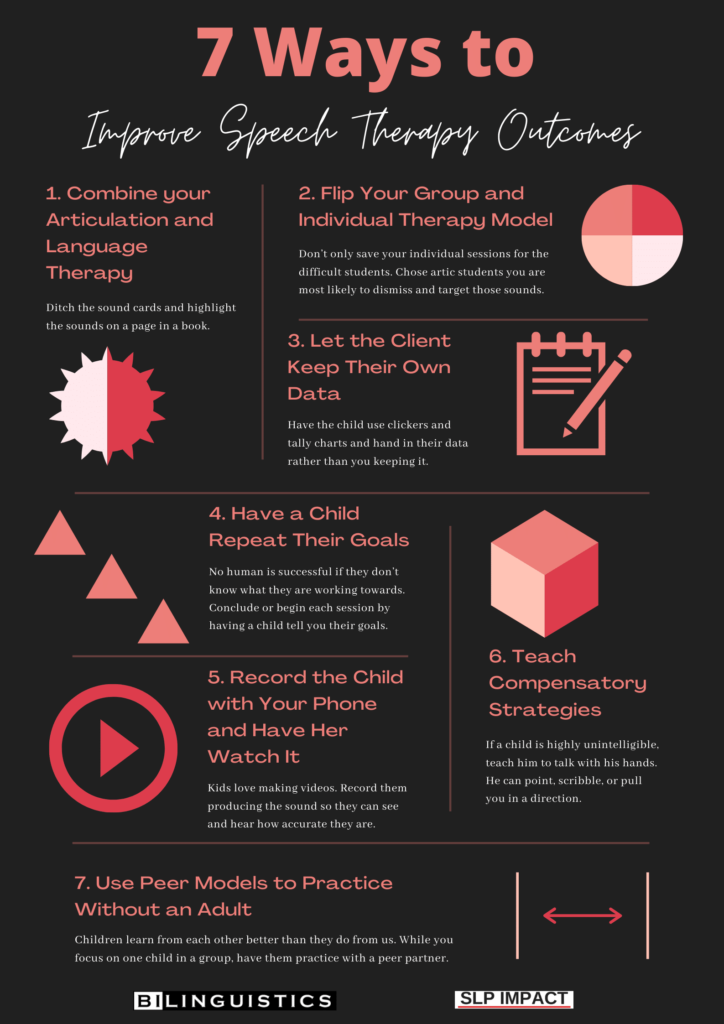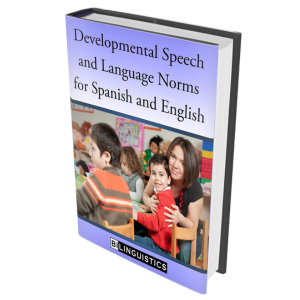I was in a conversation with a group of speech pathologists who have been working in the schools for several years. Everyone was sharing how they knock out intelligibility goals and improve speech therapy outcomes and it dawned on me that no one was actually talking about speech therapy. They were all talking about ways that they modify their sessions or focus on specific things so that what they are teaching has a greater impact.
There are seven ways to improve speech therapy outcomes within the allotted therapy time and schedule. These strategies include such things as combining speech and language goals, using technology like videos, incorporating teacher and parent support, and altering session type and activities.
These strategies go beyond what we would just consider to be articulation tactics such as improving /r/ or eliminating a tongue thrust. What it comes down to, is that if we’ve got more opportunities to use these sounds, we’re going to have more ways to practice them too. Secondly, if what we do is meaningful to the parent, teacher, AND child, we get more practice outside of speech therapy.
The 7 Strategies
There are only so many hours in the day and our students are only given so many minutes with us. Let’s start with ways we can change up our sessions or use our goals differently. Then we can talk about new things we can add to the session to make greater progress.
Before you go, we created an amazing infographic which is linked at the bottom for you to print and share.
1. Combine your Articulation and Language Therapy
Combining your articulation and language therapy has huge advantages. You can see more same-age/same-grade kids in the same groups. You are providing a way for them to use and practice the new sounds you are teaching, for example in a book. You can overlap academic topics by using their homework which gives them more opportunities to practice outside of your class.
I will even go as far as to say: ditch your articulation cards. I know, heresy right? Here’s the thinking behind this: Unless it’s an older guy, like a third, fourth, or fifth grader with R-S-L goals, we don’t need to focus on artic alone but can bake the articulation focus right in to the language and literacy-based intervention that we are already doing.
Ditch the sound cards and highlight the sounds on a page in a story book.
On this one, you could photocopy a page from a book and highlight the sounds they’re focusing on, or take the read aloud books that usually the sets have four to six books for their reading group. Take one of those at their reading level, you hit their reading level and you can mark all the Rs and Ls or whatever sound you are focusing on.
2. Flip Your Group and Individual Therapy Model
So this one goes out to all of you who are typically ending a school year with 40, 50, 60, 70 plus speech kids on your caseload. Most people save their individual therapy sessions for the odd grade or the odd disorder.
So for example, if you’ve got tons of first and second graders, they typically go in groups while your one fluency fifth grader is an individual session. Or maybe it’s your student with undesired behaviors who gets an individual session. What we are suggesting is you save at least one of your individual sessions for the artic guy that needs to get out of there.
Don’t only save your individual sessions for the difficult students. Choose articulation students you are most likely to dismiss and target those sounds so you can dismiss them.
Have him come in and focus exclusively on the last sounds he needs to get dismissed. This is not only a way to improve speech therapy outcomes but it starts to free up your schedule. After he is dismissed, who is the next most likely to be dismissed? Move her into that slot.
3. Let the Client Keep Their Own Data to Improve Speech Therapy
Do you love taking data? Are you really successful at it? I have never heard an SLP say that. Or, I have never said that myself! Well how about we admit our difficulties and just stop doing it? I know that sounds crazy. Here’s the truth though, we have a lot of difficulty collecting accurate data on all the kids sitting in front of us. And we have kids sitting in front of us that are capable of doing it themselves.
Have the child use clickers and tally charts and hand in their data rather than you keeping it.
A sound chart that relates to a specific book like the one above is a brilliant way to do this. We can also just use 10×10 boxes where they are annotating their successes. This way we really don’t have to do any math. Just count how many boxes that are not filled in out of 100 gives us our percent. Here are more examples of speech data taking.
4. Have a Child Repeat Their Goals
Have you ever made progress on a goal without measuring it? Lost weight without using a scale? Got stronger without looking at the amount of weight you are lifting? No human is successful if they don’t know what they are working towards. Conclude or begin each session by having a child tell you their goals. If you stopped a child in the hall and asked them what they were working on in speech class, they should be able to say something like: “my S sounds.”
I am going to announce radical idea #3 – no stickers just for coming to class!
Use sticker charts to the greatest effect by having the child repeat their goal when they come to class or before they leave.
I’m always amazed by how many kids don’t know what their goals are in speech. I travel around to neighboring districts and do a lot of re-evals. When I ask the kids what they are working on in speech, how many kids do you think say “play games?”
Or how about this:
“What do you work on with Ms. Johnson?”
“Ms. Johnson? The game lady?”
“Yes, the game lady, what do you guys do?”
“Read, play games, make cookies…”
Your students will be way more successful if they know their goals.
5. Record the Child with Your Phone and Have Them Watch It
We often struggle to get kids away from technology, why don’t we roll with it and let them see themselves produce the speech sounds they are having difficulty with. This can actually get really funny. Record them saying a series of words or sound. Then, turn your phone so their face is next yours. Play the recording and after they say the word, you say the word, so that they can see and hear the difference.
Kids love making videos. Record them producing the sound so they can see and hear how accurate they are.
As always, you need permission to record the child or you need to delete it but there is a great bonus for recording. If you can capture a before-and-after you will never have difficulty in an IEP meeting trying to dismiss a child. And if the video is funny, it usually livens up the meeting and gets the parent on your side.
6. Teach Compensatory Strategies
We are so heavily focused on the verbal production that we often forget about the many ways to communicate that don’t include words. Just like when you children use signs as a bridge towards verbal communication, writing and gestures can be a way to improve speech therapy outcomes by giving them the opportunity to experience being understood.
If a child is highly unintelligible, teach him to talk with his hands. He can point, scribble, or pull you in a direction. Some kids do this naturally, but most do not.
When you have highly unintelligible students, the best way to improve speech therapy outcomes is with compensatory strategies. They can be any of the following:
- signs
- gestures
- writing
- using a friend that understands them well
- using a vocabulary list that include images of the things they are working on or the things they struggle saying
- typing
- pulling you in a direction
- head movements for yes/no questions
You will get the most bang for your buck out of compensatory speech strategies especially when you have a child who is frustrated.
7. Use Peer Models to Practice Without an Adult
Lastly, when you have a group of students, what are the other students doing when you are working individually with a child? Are they sitting quietly? Are they coloring? Pair them up and have them tell their partner what they are working on, what words they are practicing, or what sounds their goals are focused on. This way you can get tons more practice out of each session.
Children learn more from each other than they do from us. While you focus on one child in a group, have them practice with a peer partner.
Also, let’s face it: kids learn more from each other than they do from us.
Bonus: Video Model for Parents or Teachers On What To Do
We talked about using videos to improve speech therapy outcomes in the speech session and the IEP meeting to show parents and teachers. I want to talk about one more strategy here that gets the parents on board so they know exactly what they should be practicing at home.
Here’s what it looks like: when you have a success,
- Send mom and dad or the teacher a video of what you are doing and how the child is responding
- Say what you are working on (We are working on /s/).
- Say what level the child is at (He can say /s/ in words, watch).
- Name any cues you give (I point at my tongue with /s/ words).
- Tell them how they can practice it in the classroom or at home (So, when you are driving say, “Stop Sign” and have him repeat).
Downloadable Chart of the 7 Ways to Improve Speech Therapy Outcomes





Interesting and affirming reading for this “retired” but professionally active SLP. The actions, methods, strategies described in this post are classics that work with children and adults in all areas of therapy, and, oh, yes – of life. Every University clinic and practicum site should have the list of 7 posted in the work area.
(And- Those arctic artic students – they’re out there. I’ve been given the cold shoulder more than once in September, especially if they’ve been in therapy for 6-7 years)
Thank you for your comment Helen. I love the idea and word play with “arctic artic” students who have just have been frozen in speech therapy time and have just been hanging out on our caseloads forever. And yes, we are trying to do more with visuals that we can hang up in our rooms to remind us to keep to the essentials and rotate onto other tired=and=true strategies if progress stalls.
Regards,
Scott
Love this! I’ve used several of these tips over the years along with a very structured home practice program so parents can practice with their child at home. It’s been years since I’ve had an artic student still in speech after 4th grade. Most are dismissed by 2nd and 3rd grade. They are effective strategies!
Glad to hear it Gina! Yes, the older artic students have to go! I think it is the quickest way to meet simultaneous demands such as serving the students well and reducing our caseload to make space for others. You brought to mind the fact that typically the older artic kids don’t have additional diagnoses such as LD which can make dismissal more difficult. Thanks for your message.
Scott.